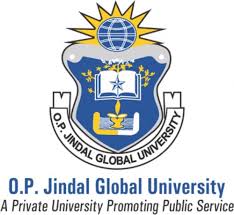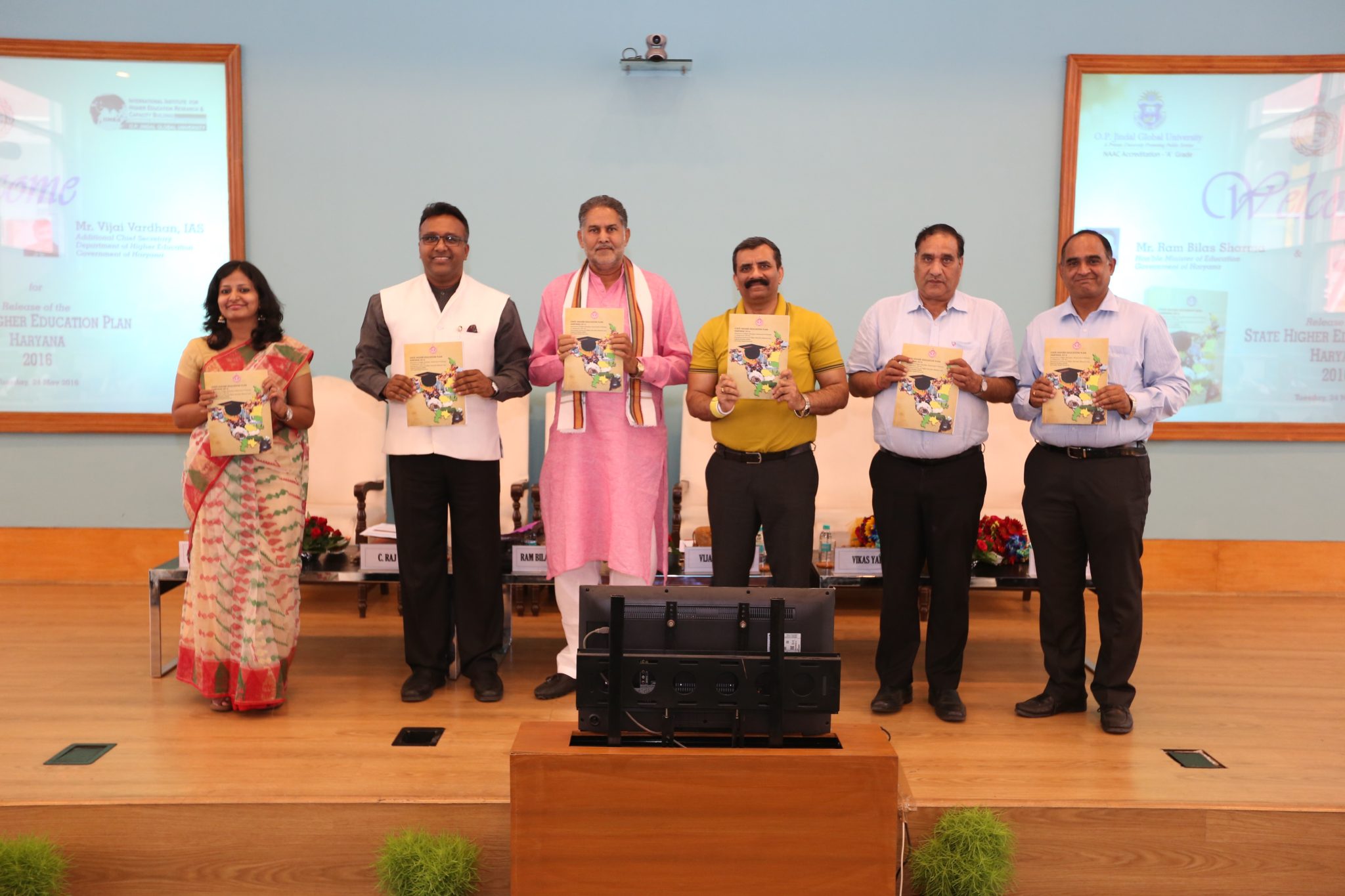- A collaborative initiative of the Department of Higher Education, Govt. of Haryana and International Institute for Higher Education & Capacity Building (IIHEd) of O.P. Jindal Global University, Haryana
- Plan identifies steep gaps in higher education accessibility between regions in Haryana and recommends measures to fill these voids
- Minster of Education, Haryana calls for implementing the State Higher Education Plan for promoting academic excellence in the state
- JGU, Vice-Chancellor, calls for improving quality and ensuring greater accessibility in higher education institutions across the country
 May 26, 2016: Shri Ram Bilas Sharma, Hon’ble Minister of Education, Haryana unveiled the State Higher Education Plan 2016, a comprehensive roadmap for revamping Haryana’s higher education landscape with an aim to boost the gross enrolment ratio, ensure greater equity, reduce inaccessibility to education, and enable the state to reap a rich demographic dividend.
May 26, 2016: Shri Ram Bilas Sharma, Hon’ble Minister of Education, Haryana unveiled the State Higher Education Plan 2016, a comprehensive roadmap for revamping Haryana’s higher education landscape with an aim to boost the gross enrolment ratio, ensure greater equity, reduce inaccessibility to education, and enable the state to reap a rich demographic dividend.
The State Higher Education Plan Haryana 2016 (SHEP) has been prepared by the Dept. of Higher Education, Govt. of Haryana in collaboration with International Institute for Higher Education & Capacity Building (IIHEd), O. P. Jindal Global University (JGU)
The document was officially released at the JGU campus in Sonipat, Haryana in the august presence of Mr. Vijai Vardhan, Additional Chief Secretary, Dept. of Higher Education, Govt. of Haryana and numerous other dignitaries, education ministry officials, senior bureaucrats and representatives of higher education institutions from across the state.
Speaking on the occasion, Mr. Ram Bilas Sharma noted, our vision is to create and promote an atmosphere of academic excellence in the state and the State Higher Education Plan 2016 is the first step in that direction. The government will systematically implement the recommendations of the SHEP and seek to achieve accessibility and quality of education in higher education institutions across the state.
Congratulating JGU and its team for their contributions in compiling the State Higher Education Plan 2016, the Minister observed that the state of Haryana was indeed proud to have a higher education institution like JGU which is not only contributing to research but is also making great progress in forging international collaborations and taking India to the world.
Mr. Ram Bilas Sharma further promised greater collaboration with JGU in the future, and said, “There will be greater collaboration with JGU on issues of higher education, and the Government of Haryana and the University will work together towards enhancing quality of higher education in the state.”
Speaking on the occasion, Mr. Vijai Vardhan,Additional Chief Secretary, Dept. of Higher Education, Govt. of Haryana noted that the State Higher Education Plan Haryana 2016 is a research intensive document that characterizes critical issues of availability, accessibility and quality in Haryana’s higher education landscape. The comprehensive document is the result of extensive education mapping exercise on areas of regional and general deficit.

Describing the importance and imperative need for the SHEP project Mr. Vijai Vardhan, observed, “Our country’s universities are tasked with producing a relevant workforce for the 21st century, nurturing minds which will create new ideas and new technologies that will drive invention, discovery and understanding. These graduates will have cutting edge ideas boosting not only personal success but national economic competitiveness.”
Mr. Vardhan also commended IIHEd and JGU for their efforts and contributions in creating a meaningful discourse on revamping higher education and expressed hope that the visionary document will help the state substantially improve and expand its education sector.
Speaking on the occasion Prof. C. Raj Kumar, Founding Vice Chancellor, O. P. Jindal Global University said, “The state of Haryana has extraordinary potential to nurture quality institutions, colleges and universities and is expected to play a leadership role in the setting up of world class universities and institutions which is in line with the key objectives of this Plan that seeks to establish Haryana as an intellectual capital of the country.”
Prof. Kumar further noted, “The state education ministry led by the honorable minister has made significant efforts towards galvanizing academic consciousness for raising the quality of higher education in the past few years, I am hopeful the government will make serious efforts to implement the State Higher Education Plan, which underlines a number of substantive issues relating to equity and access of higher education.”
Speaking of the report Nisha Nair, Senior Research Associate, Jindal Global Law School & Fellow, IIHEd, said, “Haryana can contribute tremendously in nation building initiative in the coming years as 67 % of its population is expected to fall in the working-age group of 15–59 by year 2026. The Plan moots for setting up of academic staff colleges, research centres, and institutions of research excellence in the state that will help create and inculcate a culture of research amongst the faculty and students at both institutional and state level universities and colleges of Haryana.”
Speaking at the program, Prof Anamika Srivastava, Assistant Professor, Jindal Global Law School & Fellow, IIHEd discussed the highlights of the Plan and the recommendations laid out by it. “We have tried to take into account the systemic inequalities existing in social structures that augment educational inequalities. The higher education system finds itself skewed in favor of males, urban centres as well as economically better-off citizens. The report identifies districts that have been left behind and blocks within districts that need greater focus. The report also identifies the districts which are devoid of any government university and need immediate attention,”
While there are a number of private professional institutions catering to technical education in Haryana but lack of government institutions hinders the progress of students from poor socio-economic background.
Given the rich sports, art and culture tradition of Haryana, the Plan also advocates co-opting of sports in formal education and utilization of institutional resources in promoting sports.
